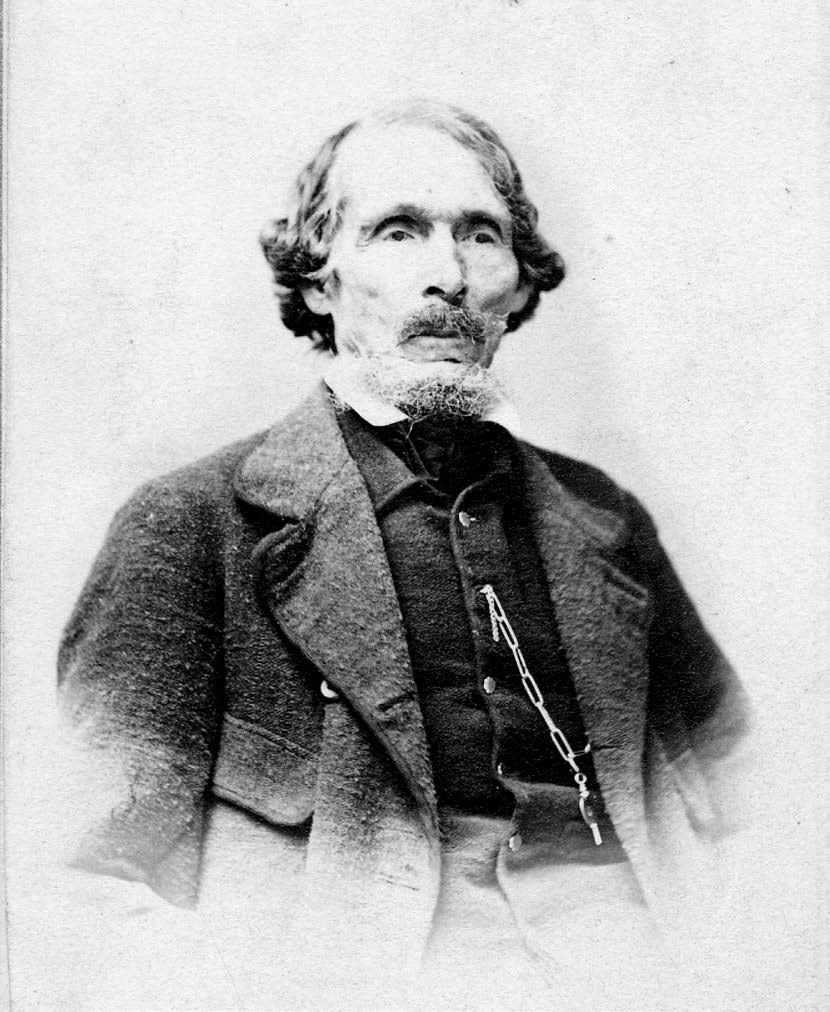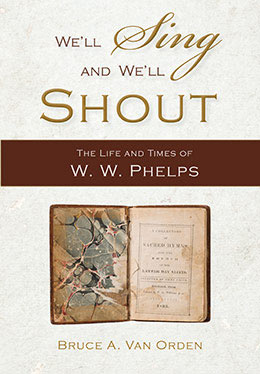Introduction
Bruce A. Van Orden, "Introduction," in We'll Sing and We'll Shout: The Life and Times of W. W. Phelps (Religious Studies Center, Brigham Young University; Salt Lake City: Deseret Book, 2018), xv–xix.
William Wines Phelps deserves more attention than he has received. Most know him only for his epic hymns. In recent years, the Joseph Smith Papers Project has revealed that W. W. Phelps was frequently at the apex of key events in the Mormon Church’s first fifteen years. My contention is that during those years (1830–1845), Phelps was among the ten most influential Latter-day Saints in developing the kingdom of God on the earth.[1]
This book’s mission is to rehabilitate the position that W. W. Phelps should hold in the Church’s earliest history. His influence in original Church leadership councils should not and cannot be denied. He served as a key leader as (1) one of the presiding high priests in Missouri from 1832 to 1834; (2) one of the presidents of the Missouri high council from 1834 to 1838, presiding over the Missouri Saints most of those years given the regular absence of David Whitmer; (3) one of the nine members of the “council of the presidents” that presided over the Church in Kirtland from May 1835 to April 1836; and (4) a key member of the “Council of Fifty” from 1844 to 1846 and when reestablished, from 1849 to 1852. Phelps’s prominent position in the Church’s press was absolutely considerable at a time in America when the press culture had such outsized influence. In a sense Phelps could be considered the “Thomas Jefferson of Mormonism,” who, as an early founder of a movement, articulated its aims and promoted the power of the press, even as Parley P. Pratt has come to be known as the “Apostle Paul of Mormonism.”[2]
This book promotes five key themes pertaining to the life of this remarkable yet controversial man:
- W. W. Phelps was a writer and poet who prominently promoted the doctrines of the causes about which he felt so strongly.
- W. W. Phelps was an accomplished printer, publisher, scholar, and promoter as expressed through the common print culture of his age.
- W. W. Phelps was exceptionally close to the Prophet Joseph Smith, much closer than previously acknowledged and appreciated. Phelps’s chief accomplishments are intimately connected to Joseph Smith’s ministry in every aspect. Seeking Zion was the prime common element of the ministries of Joseph Smith and W. W. Phelps.
- W. W. Phelps was an eccentric, a peculiar man in many ways. It seems that he was almost always filled with fire. His unusual personality affected all that he did and accomplished and was also part of his unfortunate failures.
- W. W. Phelps was sentimental about his wife Sally, family life, and the beauties of nature, although he was also frequently dogmatic on topics of women and children.
Phelps was a man of words—so many, many words. Of necessity his biography must contain noteworthy written expressions. His personality and favorite causes jumped from the pages of his newspapers, hymns, letters, and almanacs. His hymns are indeed his greatest legacy. After all, Phelps’s divinely appointed role was to provide “writings . . . for the good of the saints” (D&C 57:12). I have illustrated much of his passion, intellect, and righteous contributions, as well as his pomposity, in many quotations. However, owing to space restrictions, most of his prose, pedantry, and poetry cannot be included in this book. A forthcoming book will contain all his known poems and hymns as well as selections from his essays.
Phelps’s most extensive assignment as a Mormon was to be “a printer unto the church” (D&C 57:11). He trained as a printer’s apprentice in his youth, and from the beginning of his adult life until his old age, printing and publishing were his constant professions. When the restored Church of Christ needed a printing press and an accomplished printer, Phelps was definitely the man, the right man at the right place at the right time. He also helped train other men who became noteworthy printers and editors in their own right. Phelps possessed a unique store of knowledge of history, geography, science, and languages that he applied to his different pursuits. Arguably, he was the most learned man in the Church in Missouri, during his year-long sojourn in Kirtland, and in Nauvoo. In his own mind, he considered himself such.
Phelps dearly loved Joseph Smith Jr., who returned this affection. They were together in Smith’s first visit to Missouri in 1831 and participated together in over a hundred meetings, known usually as councils, in Jackson County, Missouri; Clay County, Missouri; Kirtland, Ohio; Far West, Missouri; Adam-ondi-Ahman, Missouri; and Nauvoo, Illinois. Their constant joint quest was building up Zion, both in terms of the sacred locations and the quality of righteous life. Through his eloquent writings, compilations of revealed scriptures, and hymn writing, Phelps promoted Joseph Smith’s teachings and ministry in the public press more than any other person up through Smith’s martyrdom. Phelps even wrote numerous doctrinal pieces in Nauvoo in behalf of Joseph Smith with Joseph’s approval. His poem or hymn “Joseph Smith,” which begins with the words “Praise to the man who communed with Jehovah!” has become perhaps the most well-known musical tribute to the Prophet.
 Portrait of W. W. Phelps, ca. 1865.
Portrait of W. W. Phelps, ca. 1865.
Throughout his life, W. W. Phelps was identified with nouns, adjectives, and titles that accentuated his unusual nature. These included zealot, crank, supercilious, haughty, partisan, firebrand, officious, erratic, impetuous, peculiar, piquant, tête montée (mounted head), “Phifer-Phelps,” “atlas of Ontario,” “speckled bird,” “strange man,” “Translator of Oriental Languages,” “King’s Jester,” and “the Devil.” He also employed multiple interesting pseudonyms. Because he was an eccentric individual by personality, he easily fell into controversy. However, under direction from Joseph Smith and later Brigham Young and the apostles, Phelps strived to modify his labors and personality to comply with more normal behavior. In many of his endeavors, he was successful in moderating his approach. In the final analysis, even though he was sometimes an eccentric, his life’s work also shows him to be a reasonable man who righteously inspired and continues to inspire many people.
Phelps loved his wife Sally and his children dearly, as evidenced by his letters to them and references to family life in his writings. Yet Phelps, like so many men of his generation in America and the Church, emphasized what he considered the God-given role of men to rule firmly over their wives and children. Present-day sensibilities are offended by some of his remarks and actions toward his wife and his puritanical rearing of his children. To understand this unusual man, we must acknowledge these unyielding attitudes as he expressed and practiced them. Phelps’s stark traits within his family carried over to his less-than-impressive experiences with polygamy later in his life.
I have strived to understand the real W. W. Phelps in previous publications.[3] In this book I have demonstrated his sincere religious feelings and standards while at the same time revealing his ambitious nature to excel and be recognized for his obvious talents. He also displayed some quirky behavioral traits. I emphasize both his strengths and faults. His 1835 patriarchal blessing, pronounced upon him by Joseph Smith Sr., illustrates the dichotomy in dealing with Phelps, his drive, and his personality: “Thou art a strange man. The Lord has given thee understanding and knowledge and wisdom, and discernment; and thou hast thought thou wast somebody; thou hast been exalted, and hast been lifted up: nevertheless, if thou continuest faithful, and humblest thyself, thou shall see great things, and have greater knowledge.”[4]
This challenge of fairly and accurately portraying a complex historical figure is, of course, not isolated to Phelps. “Most people reveal different sides of themselves in different situations, but biography-worthy figures often do it in especially striking ways. . . . Yet the multiple personalities that subjects paraded in their own time is only part of the problem. The other part is the fog that gathers around giant figures when they leave a complex legacy.”[5]
Phelps definitely had his religious side that promoted righteous works that he demonstrated time and again in his writings. In 1835 he wrote for the Latter Day Saints’ Messenger and Advocate: “[I] will close [this letter] by saying a little about doing good: Doing good for God, without vanity, without sordid selfish motives, and without the hope of fame, wealth, or earthly power. Beloved of the Lord, and friends that may be reconciled to him, religion, when defined doing good, fills the Poets description [of religion being ‘more precious than silver or gold’].”[6]
Most people who have heard of William W. Phelps think of his monumental and frequently sung hymns such as “The Spirit of God,” “Now Let Us Rejoice,” “Redeemer of Israel,” and “Praise to the Man.” But he was so much more than a hymn writer. To study his life is also to study considerably more about Joseph Smith Jr.—his leadership style, doctrines, and personality. In previous historical studies, reasonable significant connections have been made between Joseph and his wife Emma, Oliver Cowdery, Sidney Rigdon, Hyrum Smith, and Brigham Young. The present study attests a bond of similar magnitude between Joseph Smith and W. W. Phelps.
Notes
[1] My view is that these ten would include, in a rough order of importance, Joseph Smith Jr., Oliver Cowdery, Sidney Rigdon, Hyrum Smith, Brigham Young, W. W. Phelps, Heber C. Kimball, Parley P. Pratt, Edward Partridge, and Emma Hale Smith.
[2] See Terryl L. Givens and Matthew J. Grow, Parley P. Pratt: The Apostle Paul of Mormonism (New York: Oxford University Press, 2011).
[3] Bruce A. Van Orden, “‘We’ll Sing and We’ll Shout!’: Who Is the Real W. W. Phelps?,” Mormon Historical Studies 16, no. 1 (Spring 2015): 1–77. See my following articles: “W. W. Phelps: Scribe and Associate to Joseph Smith in Kirtland, 1835–1836,” John Whitmer Historical Association Journal 37, no. 1 (Spring/
[4] Patriarchal Blessings Book 2, 221, Church History Library, The Church of Jesus Christ of Latter-day Saints, Salt Lake City.
[5] Grant Wacker, “Reckoning with History: Richard Bushman, George Marsden, and the Art of Biography,” Journal of Mormon History 43, no. 2 (April 2017): 30.
[6] M&A 1, no. 4 (January 1835): 51; emphasis and spelling per original.
